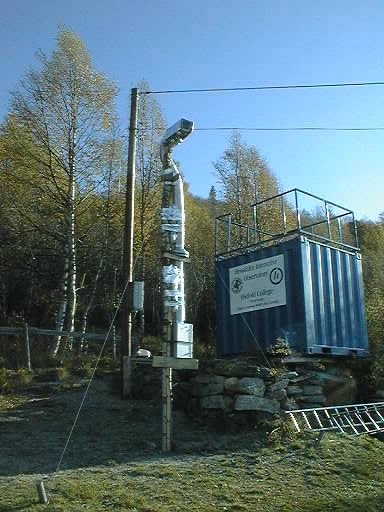
A technical description of the first system in Hessdalen AMS.
Hessdalen AMS, system 1, was set into operation, 7th August 1998, at 10 o'clock PM.
A brief description.
The station consisted of one black-and-white CCD-camera, connected to a SGI-computer
and a video-recorder. The first system had also a magnetometer, which was connected
to another computer. Whenever a sudden light showed up in the view of the
CCD-camera, an alarmpicture was send on to this web at page last alarms,
and the videorecorder was started and run for 12 seconds.
The station did also measure changes in the magnetic field,
which also was send to the Internet, and a picture was taken every hour.
A more detailed description.
Hessdalen AMS system 1 consisted of two computers, connected in a Local Area Network, Ethernet type.
One Silicon Graphics
Indy 100 MHz, with a IRIX 5.3 operating system,
and a Pentium PC, 100MHz, with a Linux
operating system. A Cisco 1003 router was setting up the ISDN connection, to
www.hessdalen.org each time data was to be transmittet.
www.hessdalen.org is the same computer as hessdalen.hiof.no, and it is located
at Østfold College in Sarpsborg.
A black-and-white Panasonic CCTV camera, type WV-BP310,
with a wide angle lens (H:107°, V:88°), type WV-LA210C3.
was connected to the SGI computer,
which had a software analysing the pictures from that camera. This software used about 0.8 second, so a
new picture is being analysed each 0.8 second. Whenever there is a change from the previous picture, bigger than a preset
difference in the intensity and the area is big enough (enough pixels), the software went into alarm-modus.
A video-recorder was started, and the picture that caused this alarm was sent to this web, on page
last alarms.
The threshold value, on which the alarm is triggered, can be adjusted. That was both number of pixels, and the difference in intensity.
The red part of the mask picture was not analysed.
The SGI computer did also send one picture to this web every hour. That was put on page
last hours.
A Fluxgate magnetometer was connected to an analog card in the Linux PC.
The magnetometer measured the magnetic field each minute, in three directions: X, which was south-north, Y, which
was east-west and Z, which was up-down. Every hour was the mean, max and min value calculated, in each direction, and sent to the page
magnetic field, where they were presented by a java program.
The readings (in nanoTesla) was
not any absolut value. It was the differense from a preset baseline (which can be changed).
The main purpose of this measurement was to see if there was any change in the magnetical field
whenever there was an observation.
I will use the opportunity to boast of (at that time) student Martin R. Thorsen. He worked
with the computers in the station during the summer of 1998. Just before it was installed in Hessdalen.
One of the task he did was to make a Linux-driver for the analog card we should use in the PC.
There were no driver present at that time for that analog card.
 |
| |
 |
| Hessdalen AMS |
The last measurement of the magnetic field with this Linux-PC was done 30.January 2001.
Some days before someone had broken into the Linux-PC. We drove to Hessdalen and installed
a newer version of Linux, includinmg a new core. It showed up that the homemade driver for the
analog card did not work with the new core. We did not want to put much work in that because
the computer was very old, and hardware failure could show up in the near future. It was better
making something based on a new computer. We took the computer with us home to the college.
The SGI computer took the last hour picture, in this setting, in June 2002. There was
a hardware failure, which was repaired March 2003. Some minutes after this repair, a new hardware failure
occured. This time the harddisk broke.
| 